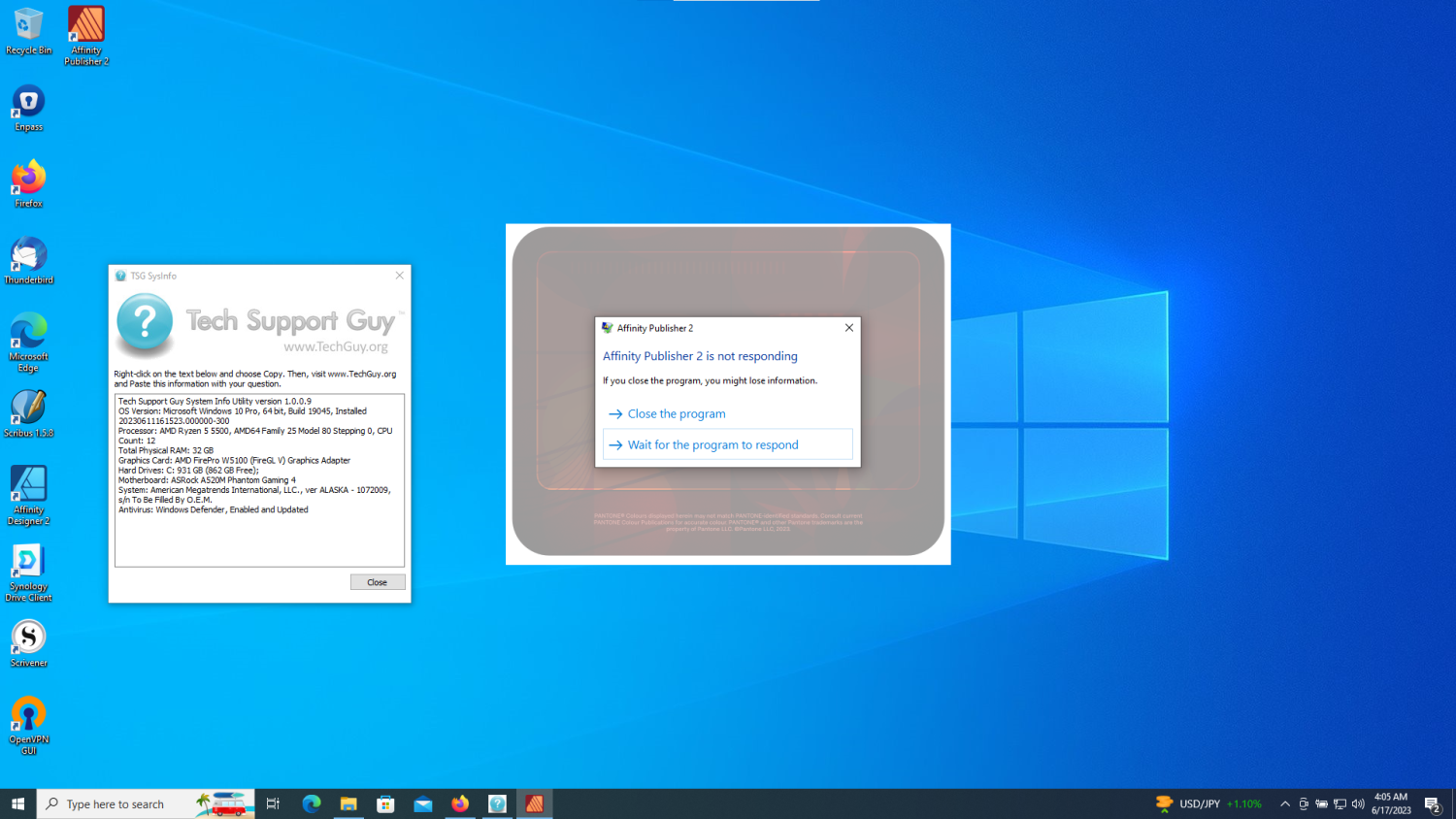Search the Community
Showing results for 'Linux'.
-
Well you disagree with Linus Torvolds who has repeatedly said Linux is not a good choice for a desktop, and it won't succeed as a general desktop system. Several major players including Dell and HP did support Linux by making it an option on their new desktops and laptops. This only lasted about a year. (I have been in the SW industry for about 40 years, though not IT) There were far too many problems even with the preinstalled Linux and low take up. That is why they dropped it. The reasons for not having it back have got greater, not lesser. To paraphrase: you may not like Windows, but it is the least-worst system we have. 🙂
-

Linux user base keep growing !
Chills replied to Wanesty's topic in Feedback for the Affinity V2 Suite of Products
I get that it is an executable file. I also read all the problems and pitfalls of Flatpak in the links posted above. Flatpak does not run on most Linux. Not by a long way. The links above show that for a companies like Affinity and BMD Flatpak is not the answer. Indeed BMD had to change Linux target a couple of years ago and went for a single Linux not flatpak. However, BMD have a small Linux user base that spend a huge amount of money with BMD. Usually in the order of 10's and 100's of thousands because BMD have a whole hardware infrastructure. The Linux market is still only 4% of the desktop market, and that 4% is heavily fragmented. In the real world it is simply isn't viable for Affinity to do a Linux version. There are far more lucrative things they could be doing. For example, a Lightroom competitor. -
I've seen your current bug reporting forums and it's a total mess. How in the world do you find any old bugs to fix them throughout all the people reporting them? It's totally chaos. No wonder you can't fix any reported bugs, the bug reporting forums is a complete mess. Your company needs to build a bug tracking system similar to Github's issue tracker, where you can assign Assignees, Labels (like bug, duplicate, enhancement, question, won't fix), Milestones, Development Branch, etc.) , etc. An effective tracking system, similar to the issue tracker feature on Github, would greatly enhance customer relations by providing a clear and efficient method for identifying and resolving issues. Top 5 reasons for a issue tracker: Improved customer satisfaction: With a comprehensive bug tracking system, customers can quickly and easily report issues, and track the progress of their resolution, leading to improved satisfaction and customer loyalty. Increased efficiency: A bug tracking system allows for better organization and prioritization of issues, enabling staff to quickly address and resolve the most critical problems. Increased transparency: A bug tracking system provides a clear and visible record of all reported issues and their status, allowing for greater transparency in the issue resolution process. Improved collaboration: A bug tracking system allows for easy collaboration among staff and customers, enabling them to share information and work together to resolve issues more efficiently. Better decision-making: A bug tracking system provides data on the number and types of issues being reported, which can be used to make informed decisions about product development and improvements. I recommend you use something like MantisBT. https://www.mantisbt.org/index.php Open source on Github: https://github.com/mantisbt/mantisbt From their website: "MantisBT is a popular open source web-based bug tracking system. Built on PHP and supports Linux, Windows and macOS on the server side. Compatible with Chrome, Firefox, Safari, Opera and IE 10+. Released under the terms of the GNU General Public License (GPL). " There, I saved you time and money!
-

Linux user base keep growing !
Chills replied to Wanesty's topic in Feedback for the Affinity V2 Suite of Products
This is true, and the 4% of Linux users make far more noise and evangelize far more than the vastly larger number of Windows users. A lot of Mac users also evangelize too, but they do have some legitimate reasons. Though less so these days. I am OS-agnostic having Windows, Linux and OSX in daily use here. (as well as other OS. RTOs and Hypervisors.) -

Linux user base keep growing !
MattyWS replied to Wanesty's topic in Feedback for the Affinity V2 Suite of Products
I'm more than willing to have an open discussion so long as you are willing to stop making insulting assumptions about my intelligence. It's ok if you disagree, but I've pointed out a bunch of different for profit softwares that are cross platform with no problems. Why would sidefx or autodesk develop their software for linux alongside windows if it was going to cost them money over time? These are for profit companies. And if it were such a huge problem to do, why are these companies still successful and still developing for linux? -

Linux user base keep growing !
Chills replied to Wanesty's topic in Feedback for the Affinity V2 Suite of Products
You really miss the point. The cost of a Linux version would not be paid for by the size of the Linux Market for Affinity. It would be subsidized by the other 96% of the Affinity customers. So I would be funding both my needs and yours. -

Affinity products for Linux
Komatös replied to a topic in Feedback for the V1 Affinity Suite of Products
I don't think there will be fully-fledged web apps. But it will certainly incorporate some of the rudimentary functions of the Affinity Suite. And as far as Linux (Wine) support is concerned, I wouldn't get my hopes up for the time being. There are enough development priorities that have priority here. Above all, the stability of the programs, RTL and CJK support (with possible extended localization), to name some. However, the development roadmap may be different! -
Affinity products for Linux
yesreallylinux replied to a topic in Feedback for the V1 Affinity Suite of Products
Soooo... Any chance the Canva acquisition will mean anything for us Linux/ChromeOS users? Webapps for Affinity like Canva in the future? -
I'm afraid that Serif Europe has made it crystal clear that there will be no Linux versions of their Affinity products not least because the Linux desktop market share still unfortunately lags well behind that of macOS. The only way I know to get a Unix-only solution to getting Affinity Photo to run on Linux is to use macOS as a VM on a Linux computer. However, there are promising developments about Affinity Photo to run in Wine on Linux as set out in this very useful discussion and the comparable one here:
- 176 replies
-
- linux
- linux photo
-
(and 2 more)
Tagged with:
-

Linux user base keep growing !
Chills replied to Wanesty's topic in Feedback for the Affinity V2 Suite of Products
The number of potential Linux users has doubled from 1% of the market to 2% of the market. In any case, Affinity will probably only support one distro of Linux, making the potential market 0.01 of the overall market. It makes ZERO commercial sense for Affinity to support Linux. -
And No seriously this is not the thread for this linux replies here will be removed
-
This is false. I installed it and it has been used in our studio on 4 Linux variants without problems, See, some companies are doing their work to meet costumer need, other just find excuses.
-

Linux user base keep growing !
Chills replied to Wanesty's topic in Feedback for the Affinity V2 Suite of Products
A few important points. Macs and Linux are VERY Different, It is like saying that because you have a blue colour Toyota Prius and a blue Ferrari they are the same. MAC is POSIX compliant and Linux is mostly POSIX compliant. However under the POSIX they are very different. The only people to port to Linux were Black Magic and that was to a custom Linux and it only worked when you use ti with the BMD hardware. Minimum investment of $100,000 a seat. When Resolve went to the inexpensive ($500) version, it was on Mac and PC. The Linux version that worked without the expensive BMD HW (that started at about $20,000 a go) came several years later. And that was only for ONE version of Linux. Linux desktop users are about 2% of the market. Not all of them will buy Commerical software in the first place. Others have estimated that the market for a Linux version of Affinity tools is sub 1% of the market. It is just not worth doing the work. -
you linked to the scripting page, this one is the Linux page;
-
Please can linux discussions be kept to the thread on that topic
-
That's very limited and false pov. E.g. majority of the large VFX business runs on Linux platforms. There is also VFX Platform initiative to unify that.
-
There is a whole thread on this. In the real world, it is a non-starter. A hell of a lot of work on multiple constantly moving targets for a VERY small market. You would never get an RoI ever. Also, the professionals don't usually use Linux.
-
@Frozen Death Knight As for what I want to actually see being developed now when you have some serious capital to back up your development, then here's a list! Linux version, or at least make it fully compatible with Proton/Wine/whatever. Pretty sure you can afford it now! - At Least a 10 year timescale for implementation, will be made available ONLY with a £400.00 a year subscription 'knight rider' plan, don't blame us, blame Canva An animation timeline for Designer and Photo with proper GIF and vector support. I want to do animated vectors in an intuitive way that's at least on par with Illustrator+After Effects - 20 years before we can implement this, this will cost you an additional £400.00, just for asking the question, and an additional £400 on top of youre 'knight rider' plan . 3D perspective tools and grids - We never heard of this, could you sketch this out on a bit of paper and we'll have a look at it Fix Windows specific drawing bugs. We'll wait and see what Canva says regarding this issue before we address it Vector brushes and erasers. What are they? More vector tools. I.e. free form gradients, blending one shape into another, node clean-up operators (merge, simplifyy, etc.), and more. ahh, We'll get back to you on that, maybe Auto-trace for Designer. Been a decade since you said you wanted to add it in. - That's a very complication operation to perform, we might have to wait until interdimensional quantum computing is solved until we can address that particular problem More game development tools for textures. Been 4 years since that teaser. - We'll wait and see what Canva says regarding this issue Cleaner lasso selections with both mouse and tablet. - Canva have told us to forget about that AI powered tools such as selection, upscaling, and some ways to integrate generative fill, whether in-house or external. With regards to A.I, we're still struggling with an 'image Trace Tool', so, like ah Finishing the plug-in system and code API. ah, you do realise that you have to have you computer plugged in at the socket, for it to switch on to use our products Make an Affinity Infinity software with all Personas in one software. I really don't want to switch softwares when I can have everything in one place. Canva have told us to forget about that More brush management features such as sub-folders, the ability to R click to select brushes, etc. NOOOOOOOOOoooooooooooooooo
-

Canva
Frozen Death Knight replied to Ash's topic in Affinity on Desktop Questions (macOS and Windows)
I will reserve my judgement in regards to this being a good thing or not. From my own experience software have developed for the worse after being acquired by much bigger companies that have vastly different business values. Examples such as Substance when bought by Adobe and Pixologic ZBrush being bought by Maxon. I don't know anything about Canva or their business culture, but I will give you over at Serif the benefit of the doubt about your decision to merge with them. Ever since I picked up Affinity back in 2017 I have come to appreciate how you have developed Affinity into something I rely on for work. You deserve that much at least. Good that you are making a promise to uphold the values that made people want to buy your software. Just to make things crystal clear however, if you break them I will simply start looking elsewhere for software that suit my needs and move on. I have learned to become a wanderer ever since Adobe began its subscription crusade over a decade ago. No hard feelings if it happens, since I have gotten used to that trust being broken. Also remember that Affinity only got to this point because of people not wanting to be forced to subscribe to Adobe, so if you are going to add subscriptions, having perpetual licenses will be key to retaining our trust. As for what I want to actually see being developed now when you have some serious capital to back up your development, then here's a list! Linux version, or at least make it fully compatible with Proton/Wine/whatever. Pretty sure you can afford it now! An animation timeline for Designer and Photo with proper GIF and vector support. I want to do animated vectors in an intuitive way that's at least on par with Illustrator+After Effects. 3D perspective tools and grids. Fix Windows specific drawing bugs. Vector brushes and erasers. More vector tools. I.e. free form gradients, blending one shape into another, node clean-up operators (merge, simplify, etc.), and more. Auto-trace for Designer. Been a decade since you said you wanted to add it in. More game development tools for textures. Been 4 years since that teaser. Cleaner lasso selections with both mouse and tablet. AI powered tools such as selection, upscaling, and some ways to integrate generative fill, whether in-house or external. Finishing the plug-in system and code API. Make an Affinity Infinity software with all Personas in one software. I really don't want to switch softwares when I can have everything in one place. More brush management features such as sub-folders, the ability to R click to select brushes, etc. Don't disappoint! -
I noticed that many people write about the fighting with maintaining old programs. They write about compatibility modes, about old systems and even about dedicated machines not maintained for decades! I wonder why nobody uses virtualization? Personally, I have Linux as the main system, but all older programs, as well as Affinity, I run on VMware Workstation, losing capacity maybe 5%. And as the main computer has a strong processor with 24 cores and a lot of RAM, in practice I completely do not feel a slowdown. But the advantage is that such a virtual is portable to a new computer (it's just a few files!) and ready to run immediately. In addition the system, in this virtual machine, can be cut off from the Internet, without anti-virus and updates: fast, clean and safe. It maintains communication with the local network and resources, e.g. with NAS. In this way, you can have any "frozen" application for any long time. Including, for example, the active AD 2.0 license, even when the servers are turned off. I recommend!
-
For the doubters, as with any VC funded company (who also dabbles in AI), this is what will inevitably happen: https://americandialect.org/2023-word-of-the-year-is-enshittification/ So now it's only a question about WHEN, but the shitty thing is that Affinity quite recently denied there even was a question of IF: Now that their true colors have been revealed, you can't trust anything anyone from that company says ever again and we can safely assume that the timeline to things going down the drain has been accelerated. https://mastodon.cloud/@designthinkingcomic/112172752241749103 So... guess I'm forced to look at Inkscape once again for an Illustrator alternative. At least there's some more options for Photoshop alternatives. Not really any alternatives for Indesign, though? At least not for Linux (which I'm probably moving to in the next few years due to the similar crap happening to Windows).
-
I'm using a PC which I built last year for general purpose use including writing and video work (DaVinci Resolve) under Linux. My book manuscript is almost ready for publication and I wanted to try the Affinity suite to prepare it for prepress. I purchased a new copy of Windows 10 and installed it as a dual-boot system, then installed the 30-day trial of the Affinity products. However, I have not been able to get the Affinity programs to operate properly under Windows. They report successful installation, but never go beyond the initial logo screen and eventually Windows tells me, "Affinity Publisher 2 is not responding" and offers me no choice except to continue to wait or to exit the program. This is frustrating because, before purchasing Windows, I successfully installed and ran the Affinity suite on the Linux side in VirtualBox using an unregistered Windows install for evaluation purposes. It was slow but appeared to be fully functional, and I expected it to work much better with a native and activated Windows OS. Instead, it's unusable. I posted this under the Windows Support forum and another user suggested that I try enabling/disabling hardware acceleration. It didn't make a difference; I received the same results either way. I've also tried with both the .msix and .exe installers, using the latter with "Run as Administrator." No help. The other forum user suggested that my AMD graphics card might be causing the incompatibility. Possible, but I'm not going to jettison a graphics card I'm happy with and which runs all the other software I use because of a problem with this one program. I'm not going to be moving forward with my purchase of the Affinity suite at this time (can you blame me?), but I'm still in need of a good .pdf generator for my book manuscript. If you resolve this issue please let me know and I'll reconsider purchase. In the meantime, I'm trying to learn Scribus. My system information (courtesy TechGuy.org): Tech Support Guy System Info Utility version 1.0.0.9 OS Version: Microsoft Windows 10 Pro, 64 bit, Build 19045, Installed 20230611161523.000000-300 Processor: AMD Ryzen 5 5500, AMD64 Family 25 Model 80 Stepping 0, CPU Count: 12 Total Physical RAM: 32 GB Graphics Card: AMD FirePro W5100 (FireGL V) Graphics Adapter Hard Drives: 😄 931 GB (862 GB Free); Motherboard: ASRock A520M Phantom Gaming 4 System: American Megatrends International, LLC., ver ALASKA - 1072009, s/n To Be Filled By O.E.M. Antivirus: Windows Defender, Enabled and Updated
-
If Canva actually implements its 4-point plan as announced, the acquisition could be a win-win for everyone. I am thinking here of the users who would like to use the Affinity programs on Linux or on an Android tablet. And those who would like to work in a team on the same project. All this and much more could be realized through the merger. Canva may not have the best reputation, but they can ensure that their popularity increases with a smart approach. A smart approach would include offering stand-alone apps at a fair price so that people on low incomes can afford them too. Time will tell what will become of the award-winning software. Until then, it's a case of wait and see.
-
Questions on Canva acquiring Affinity
My1 replied to kaffeeundsalz's topic in Customer Service, Accounts and Purchasing
of course, that too. I am going even further I am trying to look for something that actually works on linux, would be neat -
Questions on Canva acquiring Affinity
hds replied to kaffeeundsalz's topic in Customer Service, Accounts and Purchasing
I use Linux and a ton of FOSS/FLOSS software. Inkscape is definitely no replacement for Illustrator or Designer. That's why the devs from Affinity need to fix Inkscape when they get laid off in 6 months from the Canva family.









